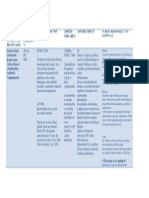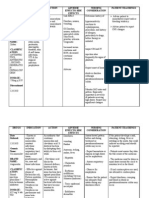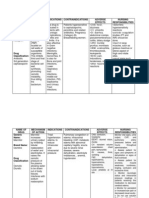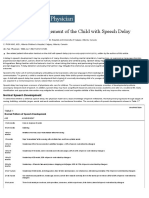0 ratings0% found this document useful (0 votes)
61 viewsDrug Study: Cavite State University (Cvsu)
Drug Study: Cavite State University (Cvsu)
Uploaded by
Angelica Cassandra VillenaThis document contains a drug study for a patient named JN who was admitted on August 7, 2014 for pulmonary tuberculosis (PTB). The drug cefuroxime is prescribed to treat the patient's infection. Cefuroxime is a second-generation cephalosporin antibiotic that works by binding to bacterial cell walls and causing cell death. It is prescribed for respiratory, skin, bone, joint, urinary, and gynecological infections. The document outlines the dosage, effects, contraindications, nursing responsibilities, and patient teaching for cefuroxime administration and monitoring.
Copyright:
© All Rights Reserved
Available Formats
Download as DOCX, PDF, TXT or read online from Scribd
Drug Study: Cavite State University (Cvsu)
Drug Study: Cavite State University (Cvsu)
Uploaded by
Angelica Cassandra Villena0 ratings0% found this document useful (0 votes)
61 views2 pagesThis document contains a drug study for a patient named JN who was admitted on August 7, 2014 for pulmonary tuberculosis (PTB). The drug cefuroxime is prescribed to treat the patient's infection. Cefuroxime is a second-generation cephalosporin antibiotic that works by binding to bacterial cell walls and causing cell death. It is prescribed for respiratory, skin, bone, joint, urinary, and gynecological infections. The document outlines the dosage, effects, contraindications, nursing responsibilities, and patient teaching for cefuroxime administration and monitoring.
Original Description:
drug study
Original Title
Ce Fur Oxime
Copyright
© © All Rights Reserved
Available Formats
DOCX, PDF, TXT or read online from Scribd
Share this document
Did you find this document useful?
Is this content inappropriate?
This document contains a drug study for a patient named JN who was admitted on August 7, 2014 for pulmonary tuberculosis (PTB). The drug cefuroxime is prescribed to treat the patient's infection. Cefuroxime is a second-generation cephalosporin antibiotic that works by binding to bacterial cell walls and causing cell death. It is prescribed for respiratory, skin, bone, joint, urinary, and gynecological infections. The document outlines the dosage, effects, contraindications, nursing responsibilities, and patient teaching for cefuroxime administration and monitoring.
Copyright:
© All Rights Reserved
Available Formats
Download as DOCX, PDF, TXT or read online from Scribd
Download as docx, pdf, or txt
0 ratings0% found this document useful (0 votes)
61 views2 pagesDrug Study: Cavite State University (Cvsu)
Drug Study: Cavite State University (Cvsu)
Uploaded by
Angelica Cassandra VillenaThis document contains a drug study for a patient named JN who was admitted on August 7, 2014 for pulmonary tuberculosis (PTB). The drug cefuroxime is prescribed to treat the patient's infection. Cefuroxime is a second-generation cephalosporin antibiotic that works by binding to bacterial cell walls and causing cell death. It is prescribed for respiratory, skin, bone, joint, urinary, and gynecological infections. The document outlines the dosage, effects, contraindications, nursing responsibilities, and patient teaching for cefuroxime administration and monitoring.
Copyright:
© All Rights Reserved
Available Formats
Download as DOCX, PDF, TXT or read online from Scribd
Download as docx, pdf, or txt
You are on page 1of 2
Republic of the Philippines
CAVITE STATE UNIVERSITY
(CvSU)
Don Severino Delas Alas Campus
Indang, Cavite
(046) 4150-010 / 4150-011 (046) 4150-012
DRUG STUDY
NAME OF PATIENT: JN DATE OF ADMISSION: AUGUST 7, 2014
AGE: 33 YEARS OLD DIAGNOSIS: PTB
SEX: FEMALE
Drug Features
Mechanism of
Action
Indication
Contraindication
Effects Nursing Responsibilities
Generic Name:
Cefuroxime
Brand Name:
none
Classification:
anti-infectives
Sub Classification:
second-generation
cephalosporins
Dosage:
500 mg 1 tab
Route:
PO
Frequency:
BID
Form:
Film coated tablet
Binds to
bacterial cell
wall membrane,
causing cell
death.
Therapeutic
Effects:
Bactericidal
action against
susceptible
bacteria.
Spectrum:
Similar to that of
first-generation
cephalosporins
but has
increased
activity against
several other
gram-negative
pathogens
including:
Haemophilus
Treatment of:
Respiratory tract
infections, Skin and
skin structure
infections, Bone
and joint infections
(IV), Urinary tract
infections,
Gynecological
infections,
Septicemia (IV),
Otitis media (PO),
Meningitis (IV),
Lyme disease (PO).
Perioperative
prophylaxis (IV).
Contraindicated in:
Hypersensitivity to
cephalosporins;
Serious
hypersensitivity to
penicillins.
Use Cautiously in:
Renal impairment
(dose
reduction/increase
d dosing interval
recommended if
CCr 20 mL/min);
History of GI
disease, especially
colitis; Geriatric
patients (dose
adjustment may be
required due to
Side Effects &Adverse
Effects
CNS: SEIZURES (HIGH
DOSES). GI:
PSEUDOMEMBRANOUS
COLITIS, diarrhea,
nausea, vomiting,
cramps. Derm: rashes,
urticaria, diaper
dermatitis. Hemat:
bleeding, eosinophilia,
hemolytic anemia,
leukopenia. Local: pain
at IM site, phlebitis at IV
site. Misc: ALLERGIC
REACTIONS INCLUDING
ANAPHYLAXIS,
superinfection.
Check for doctors order
Carefully read product packaging to note
strength of solution, dosage/ route of
administration.
Observe 10 Rs in medicine
administration
Assessment:
Assess for infection (vital signs;
appearance of wound, sputum, urine,
and stool; WBC) at beginning of and
throughout therapy.
Before initiating therapy, obtain a history
to determine previous use of and
reactions to penicillins or
cephalosporins. Persons with a negative
history of penicillin sensitivity may still
have an allergic response.
Obtain specimens for culture and
sensitivity before initiating therapy. First
dose may be given before receiving
results.
Observe patient for signs and symptoms
of anaphylaxis (rash, pruritus, laryngeal
edema, wheezing). Discontinue the drug
and notify health care professional
immediately if these symptoms occur.
Keep epinephrine, an antihistamine, and
resuscitation equipment close by in the
event of an anaphylactic reaction.
influenzae
(including -
lactamase-
producing
strains),
Haemophilus
parainfluenzae,
Escherichia coli,
Klebsiella
pneumoniae,
Neisseria ,
Proteus,
Moraxella
catarrhalis,
Borrelia
burgdorferi. Not
active against
methicillin-
resistant
staphylococci or
enterococci.
age-related in
renal function);
Pregnancy and
lactation (has been
used safely).
Monitor bowel function. Diarrhea,
abdominal cramping, fever, and bloody
stools should be reported to health care
professional promptly as a sign of
pseudomembranous colitis. May begin
up to several weeks following cessation
of therapy.
Lab Test Considerations: May cause
positive results for Coombs' test.
May cause serum AST, ALT, alkaline
phosphatase, bilirubin, LDH, BUN, and
creatinine.
May rarely cause leukopenia,
neutropenia, and eosinophilia.
Patient/Family Teaching:
Instruct patient to take medication
around the clock at evenly spaced times
and to finish the medication completely,
even if feeling better. Missed doses
should be taken as soon as possible
unless almost time for next dose; do not
double doses. Advise patient that sharing
of this medication may be dangerous.
Pedi: Tell parents or cargeivers to use
calibrated measuring device with liquid
preparations.
Advise patient to report signs of
superinfection (furry overgrowth on the
tongue, vaginal itching or discharge,
loose or foul-smelling stools) and allergy.
Instruct patient to notify health care
professional if fever and diarrhea
develop, especially if stool contains
blood, pus, or mucus. Advise patient not
to treat diarrhea without consulting
health care professional.
SUBMITTED BY: ANGELICA CASSANDRA P. VILLENA CLINICAL INSTRUCTOR: EDERLYN P. DESTURA RN, MAN
YEAR & SEC. GRP: BSN 3 1 GRP 1
DATE: AUGUST 15, 2014
You might also like
- USMLE Step 3 Lecture Notes 2021-2022: Internal Medicine, Psychiatry, EthicsFrom EverandUSMLE Step 3 Lecture Notes 2021-2022: Internal Medicine, Psychiatry, EthicsRating: 5 out of 5 stars5/5 (9)
- CefoxitinDocument3 pagesCefoxitinAngelica Cassandra VillenaNo ratings yet
- Cefixime Drug StudyDocument2 pagesCefixime Drug StudyJonalin Magbanua100% (12)
- Naplex Complete Study Outline A Topic-Wise Approach DiabetesFrom EverandNaplex Complete Study Outline A Topic-Wise Approach DiabetesRating: 4 out of 5 stars4/5 (3)
- EcomapDocument1 pageEcomapAngelica Cassandra VillenaNo ratings yet
- CEFRADINEDocument2 pagesCEFRADINEAngelica Cassandra VillenaNo ratings yet
- CefazolinDocument3 pagesCefazolinDanielle Marie SamblacenoNo ratings yet
- Medication Card AncefDocument2 pagesMedication Card AncefEllieNo ratings yet
- ZegenDocument2 pagesZegenianecunar100% (3)
- Document - Drug Card OneDocument3 pagesDocument - Drug Card OneLinda AdamsonNo ratings yet
- Drug StudyDocument4 pagesDrug Studym100% (1)
- CefazolinDocument2 pagesCefazolinConn_Casipe_8158100% (1)
- Cefepime MaxipimeDocument2 pagesCefepime MaxipimeKristi Wray100% (1)
- Generic NameDocument2 pagesGeneric NamePei BartolomeNo ratings yet
- CephalexinDocument1 pageCephalexinJehadadNo ratings yet
- Drug Study EditedDocument5 pagesDrug Study EditedfabtaciousVeelaNo ratings yet
- Generic NameDocument8 pagesGeneric Namemel aquinoNo ratings yet
- Ampicillin Drug StudyDocument2 pagesAmpicillin Drug Studymilkv92% (12)
- Oral Suspension: 125 mg/5 Powder For Injection: 750 Premixed Containers: 750Document1 pageOral Suspension: 125 mg/5 Powder For Injection: 750 Premixed Containers: 750Diane Grace PadillaNo ratings yet
- Drug Study - CefuroximeDocument2 pagesDrug Study - CefuroximeSiergs Smith GervacioNo ratings yet
- What Is The Appendix?: Symptoms of AppendicitisDocument6 pagesWhat Is The Appendix?: Symptoms of AppendicitisVonn Bryan CalumiaNo ratings yet
- CeftazidimeDocument1 pageCeftazidimePaulineNo ratings yet
- Drug Study: Notre Dame of Tacurong CollegeDocument2 pagesDrug Study: Notre Dame of Tacurong CollegeApol PenNo ratings yet
- CefuroximeDocument1 pageCefuroximeRox SanNo ratings yet
- Drug Study NCP - San LazaroDocument9 pagesDrug Study NCP - San LazaroLynne CammayoNo ratings yet
- CeftriaxoneDocument1 pageCeftriaxoneJanine Erika Julom BrillantesNo ratings yet
- Drug StudyDocument6 pagesDrug StudyRyan BancoloNo ratings yet
- NR at MADocument4 pagesNR at MAAngie MandeoyaNo ratings yet
- Drug Study On CloxacillinDocument2 pagesDrug Study On CloxacillinRoanne LaguaNo ratings yet
- Cephalexin: Adjust-A-Dose (For All Indications)Document3 pagesCephalexin: Adjust-A-Dose (For All Indications)HannaNo ratings yet
- Antibiotics: Mos.: 25-50 Mg/kg/day in 3 Divided Doses. Children 3 Mos and Younger: 30Document9 pagesAntibiotics: Mos.: 25-50 Mg/kg/day in 3 Divided Doses. Children 3 Mos and Younger: 30Kath TagamolilaNo ratings yet
- CeftriaxoneDocument5 pagesCeftriaxoneCastillo MikaellaNo ratings yet
- Augmenten (Amoxicillin Clavulan)Document2 pagesAugmenten (Amoxicillin Clavulan)Adrianne BazoNo ratings yet
- DrugsDocument11 pagesDrugsElisa Libo-onNo ratings yet
- Albuterol Drug StudyDocument7 pagesAlbuterol Drug StudyMaria Charlene OrpillaNo ratings yet
- Drug AmpicillinDocument2 pagesDrug AmpicillinRenz Ivan FuntilonNo ratings yet
- CEPHALOSPORINSDocument8 pagesCEPHALOSPORINSShreyas WalvekarNo ratings yet
- Pat 2 sd-1Document22 pagesPat 2 sd-1api-283672381No ratings yet
- RocephinDocument2 pagesRocephinianecunar100% (2)
- Drug Card Grid: Absorption, Distribution, Metabolism, Excretion)Document2 pagesDrug Card Grid: Absorption, Distribution, Metabolism, Excretion)Khaleel BalogunNo ratings yet
- Enoxirt CeftraxioneDocument10 pagesEnoxirt CeftraxioneAhmed DawodNo ratings yet
- Drug Study FinalDocument5 pagesDrug Study FinalJackie Ann Marie DapatNo ratings yet
- V. Laboratory Result and Diagnostic ExaminationDocument23 pagesV. Laboratory Result and Diagnostic ExaminationAvigael Gabriel AvilesNo ratings yet
- Brand NameDocument2 pagesBrand NameAshley AleaNo ratings yet
- Drug Study Drug Name: Ceftriaxone A. ClassificationDocument2 pagesDrug Study Drug Name: Ceftriaxone A. ClassificationMark BarengNo ratings yet
- Mefenamic AcidDocument3 pagesMefenamic AcidAngelica Cassandra VillenaNo ratings yet
- CeftriaxoneDocument1 pageCeftriaxoneleroux2890100% (2)
- Drug StudyDocument6 pagesDrug StudyFloramae Celine BosqueNo ratings yet
- Invanz (Ertapenem)Document2 pagesInvanz (Ertapenem)E100% (1)
- AmpicillinDocument1 pageAmpicillinMichael KuzbytNo ratings yet
- Antibiotic Penicillin: Ampicillin Ampicillin Sodium AmpicillinDocument3 pagesAntibiotic Penicillin: Ampicillin Ampicillin Sodium AmpicillinMaria Delia SalvadoNo ratings yet
- Tramadol, Ketorolac, EterocoxibDocument4 pagesTramadol, Ketorolac, EterocoxibEric de JulianNo ratings yet
- History of Present Illness: Magno, Corisette Corsino Flores C C C C C C C CDocument4 pagesHistory of Present Illness: Magno, Corisette Corsino Flores C C C C C C C CDaniele Katrina PimentelNo ratings yet
- Classification: Cefditoren, As This Agent May CauseDocument3 pagesClassification: Cefditoren, As This Agent May CauseHavier EsparagueraNo ratings yet
- Drug Study-Ceftriaxone ClindamycinDocument2 pagesDrug Study-Ceftriaxone ClindamycinDavid VillanuevaNo ratings yet
- Drug StudyDocument9 pagesDrug StudyShiara Ruth EdrosoloNo ratings yet
- 8 G/day: Source: Source: Source: Source: Source: Source: SourceDocument1 page8 G/day: Source: Source: Source: Source: Source: Source: SourcefairwoodsNo ratings yet
- Drug StudyDocument7 pagesDrug StudyJuliana LegarteNo ratings yet
- The Essential Guide to Cephalexin: Usage, Precautions, Interactions and Side Effects.From EverandThe Essential Guide to Cephalexin: Usage, Precautions, Interactions and Side Effects.No ratings yet
- Marcos Administration: Capv, Bsa 2-6Document2 pagesMarcos Administration: Capv, Bsa 2-6Angelica Cassandra VillenaNo ratings yet
- 8.-ANATOMY and Physiology GIDocument12 pages8.-ANATOMY and Physiology GIAngelica Cassandra VillenaNo ratings yet
- Sustainability in NursingDocument18 pagesSustainability in NursingAngelica Cassandra VillenaNo ratings yet
- Appendicitis PathophysiologyDocument4 pagesAppendicitis PathophysiologyAngelica Cassandra VillenaNo ratings yet
- Mental Health ActDocument9 pagesMental Health ActAngelica Cassandra Villena100% (1)
- Lcohol: Key FactsDocument4 pagesLcohol: Key FactsAngelica Cassandra VillenaNo ratings yet
- Physical Activity: Key FactsDocument4 pagesPhysical Activity: Key FactsAngelica Cassandra VillenaNo ratings yet
- BibliographyDocument2 pagesBibliographyAngelica Cassandra VillenaNo ratings yet
- Lcohol: Key FactsDocument4 pagesLcohol: Key FactsAngelica Cassandra VillenaNo ratings yet
- Mefenamic AcidDocument3 pagesMefenamic AcidAngelica Cassandra VillenaNo ratings yet
- Art 8Document27 pagesArt 8Angelica Cassandra VillenaNo ratings yet
- Drug Study: Don Severino Delas Alas Campus Indang, Cavite (046) 4150-010 / 4150-011 (046) 4150-012Document1 pageDrug Study: Don Severino Delas Alas Campus Indang, Cavite (046) 4150-010 / 4150-011 (046) 4150-012Angelica Cassandra VillenaNo ratings yet
- Department of Health: History, Policy, Budget, Programs For HealthDocument57 pagesDepartment of Health: History, Policy, Budget, Programs For HealthAngelica Cassandra VillenaNo ratings yet
- CETIRIZINEDocument2 pagesCETIRIZINEAngelica Cassandra Villena100% (10)
- Reader ResponseDocument2 pagesReader ResponseAngelica Cassandra VillenaNo ratings yet
- Typology of A Problem and Family Nursing Care PlanDocument11 pagesTypology of A Problem and Family Nursing Care PlanAngelica Cassandra Villena100% (1)
- Community NCP Personal HygieneDocument2 pagesCommunity NCP Personal HygieneAngelica Cassandra Villena67% (3)
- Upper Respiratory Tract Infection NCPDocument2 pagesUpper Respiratory Tract Infection NCPAngelica Cassandra Villena100% (2)
- GenogramDocument1 pageGenogramAngelica Cassandra VillenaNo ratings yet
- Patricia Benner: From Novice To ExpertDocument25 pagesPatricia Benner: From Novice To ExpertAngelica Cassandra VillenaNo ratings yet
- Prioritization of Health ProblemDocument1 pagePrioritization of Health ProblemAngelica Cassandra VillenaNo ratings yet
- Physical HazardsDocument2 pagesPhysical HazardsAngelica Cassandra VillenaNo ratings yet
- Poster SSM 2015 DUADocument1 pagePoster SSM 2015 DUAHuy Trần ThiệnNo ratings yet
- Internal Medicine Long Case 5Document7 pagesInternal Medicine Long Case 5RoshilNo ratings yet
- Chapter 12 - Nervous SystemDocument34 pagesChapter 12 - Nervous SystemMelesNo ratings yet
- Somatosensory Evoked PotentialsDocument100 pagesSomatosensory Evoked PotentialsIami MenotuNo ratings yet
- Homam ProductsDocument6 pagesHomam ProductsRama KarthikNo ratings yet
- Cognitive Psychology JournalDocument3 pagesCognitive Psychology JournalMcKayla ChurchNo ratings yet
- IMS US Diabetes MarketDocument6 pagesIMS US Diabetes MarketsyedNo ratings yet
- Introduction To Psychiatry and Chinese HistoryDocument15 pagesIntroduction To Psychiatry and Chinese HistoryPickering and ChattoNo ratings yet
- The Body Hunters: Testings New Drugs On The World's Poorest Patients (PDFDrive)Document231 pagesThe Body Hunters: Testings New Drugs On The World's Poorest Patients (PDFDrive)Ange Fabrice N'DANo ratings yet
- Inguinal HerniaDocument6 pagesInguinal HerniaignatiuserikNo ratings yet
- MRCPCH 2 Questions For May 2015Document4 pagesMRCPCH 2 Questions For May 2015Saadia JavaidNo ratings yet
- DRUG STUDY - AminophyllineDocument2 pagesDRUG STUDY - AminophyllineKian Herrera100% (3)
- Evaluation and Management of The Child With Speech Delay - American Family PhysicianDocument6 pagesEvaluation and Management of The Child With Speech Delay - American Family PhysicianPoh Guan KhawNo ratings yet
- Rle Lesson 3 Comprehensive Geriatric AssessmentDocument9 pagesRle Lesson 3 Comprehensive Geriatric AssessmentRoselyn Yu QuintoNo ratings yet
- Duloxetine As Adjunctive Treatment To CL PDFDocument8 pagesDuloxetine As Adjunctive Treatment To CL PDFAlexandra PopaNo ratings yet
- Nsal InstillationDocument4 pagesNsal InstillationNeelofur Ibran Ali100% (4)
- Science 10 Q3 Module 3Document26 pagesScience 10 Q3 Module 3090406No ratings yet
- Amphetamine AdderallDocument2 pagesAmphetamine AdderallKristi Wray100% (1)
- Instant Ebooks Textbook The Color Atlas and Synopsis of Family Medicine Richard P. Usatine Download All ChaptersDocument33 pagesInstant Ebooks Textbook The Color Atlas and Synopsis of Family Medicine Richard P. Usatine Download All ChapterszogajjolganNo ratings yet
- Guía Europea HTA 2024Document15 pagesGuía Europea HTA 2024hokano4953No ratings yet
- M2 Rad AnaDocument11 pagesM2 Rad AnaramilccabrigaNo ratings yet
- Braddoms 2020 - Capitulo 10 - Protesis Eeii y MarchaDocument38 pagesBraddoms 2020 - Capitulo 10 - Protesis Eeii y MarchaSergio Navarrete VidalNo ratings yet
- Thyroid Cancer-Case StudyDocument7 pagesThyroid Cancer-Case Studyapi-270166097100% (1)
- AlphaDocument17 pagesAlphaMovie SourceNo ratings yet
- Infection Control IcuDocument37 pagesInfection Control IcuVidit JoshiNo ratings yet
- NadiDocument4 pagesNadiKrishnaswamy JajimoggalaNo ratings yet
- Iaat12i5p615 PDFDocument6 pagesIaat12i5p615 PDFsuresh kumar bakhtianiNo ratings yet
- Diabetes Mellitus by BaddiriDocument34 pagesDiabetes Mellitus by BaddiriJason AbudaNo ratings yet
- Ways To Repair A Broken Heart Quickly!Document2 pagesWays To Repair A Broken Heart Quickly!sordusc4y5No ratings yet
- 07aprc - SyokDocument28 pages07aprc - SyokSondang Herikson PanjaitanNo ratings yet














































































































